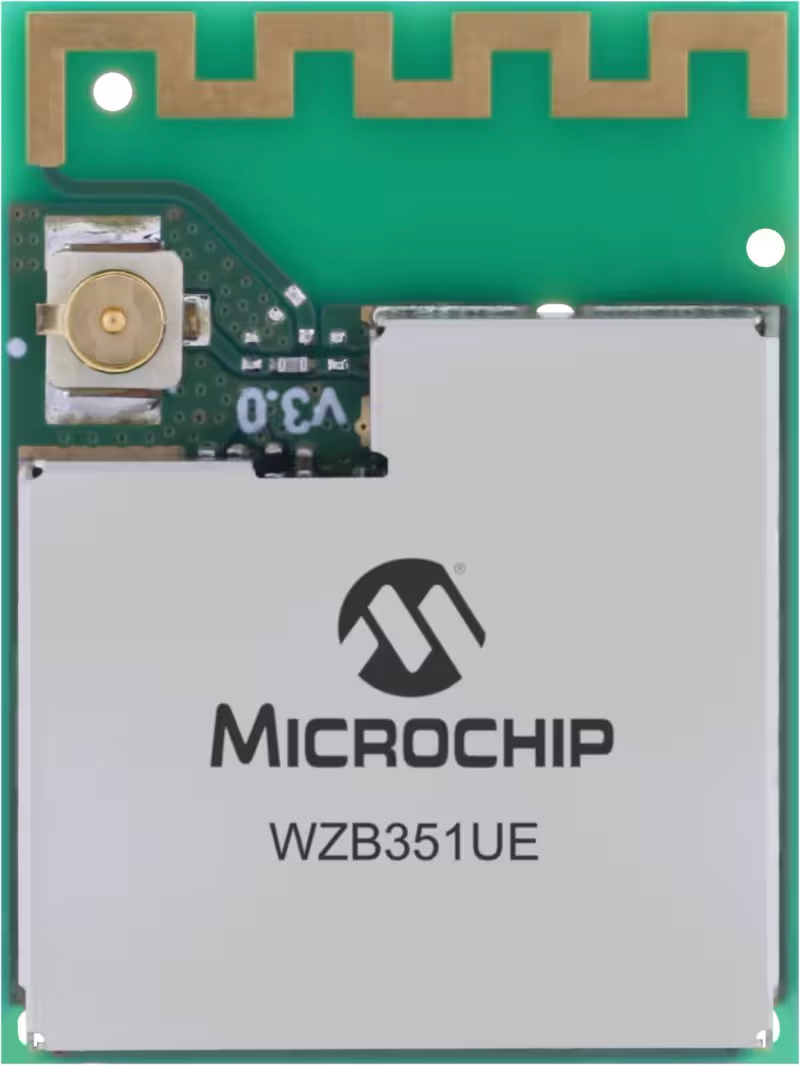

Microchip WBZ351UE Microcontroller Module
Featuring an inbuilt wireless subsystem
The WBZ351UE by Microchip is a secure, low-cost 32-bit microcontroller module that’s part of the PIC32CX-BZ3 family. It features an integrated wireless subsystem certified for Bluetooth® and Zigbee®, and is built to help accelerate time to market. Powered by a 64 MHz ARM® Cortex® M4F core, this module offers robust performance and a rich feature set.
The WBZ351UE is equipped with a U.FL connector for use with an external antenna, making it ideal for wireless applications where a PCB antenna is not feasible. RF design can be complex, but this module simplifies implementation with its RF-ready architecture and external antenna support—no need to be an RF expert to get started, saving time and reducing design costs.
Pre-certified for regulatory compliance in the US, Canada, Europe, China, Taiwan, Japan, and Korea, the WBZ351UE helps speed up product launches by removing the burden of lengthy radio certification processes.
It includes an ultra-low power 2.4 GHz transceiver that enables Bluetooth Low Energy (LE) 5.2 and IEEE® 802.15.4 / Zigbee 3.0 connectivity, with hardware-level arbitration for true multi-protocol support.
The module offers hardware-based security with NIST-compliant authentication and secure boot ROM to ensure only trusted software can run.
Industrial-grade analog peripherals such as capacitive touch, ADCs, DAC, and comparators make the WBZ351UE suitable for a wide range of sensor and analog management applications.
Designed with safety-critical applications in mind, the WBZ351UE supports ISO 26262 (ASIL B) and IEC 61508 (SIL 2) functional safety standards. A Functional Safety Manual, FMEDA, and Diagnostic Software details are available under NDA—contact for more information.
Development is streamlined using the MPLAB® Harmony® v3 framework, which offers intuitive drag-and-drop tools and demo applications to help developers start prototyping in seconds. A comprehensive application developer’s guide is available to support the design process, including a step-by-step tutorial for those new to wireless development.
Summary of Features
|
|
Applications
|
|
Hardware
PIC32CX-BZ3 and WBZ35x Curiosity Board
 | The PIC32CX-BZ3 and WBZ35x Curiosity board is preconfigured with an out-of-the-box sensor application that demonstrates Bluetooth LE. You can also evaluate the CVD Touch functionality by adding the QT7 Xplained Pro extension kit. Additional Bluetooth and Zigbee application examples are available in MPLAB® Harmony v3. This development kit includes:
|
More Information
RF Ready with Onboard Antenna
RF design is complicated but the WBZ351 makes it easier. With our RF-ready, PCB antenna, you don’t need to be an RF-expert to add wireless to your application, saving you time and RF-design costs.
Global Regulatory-Certified
Radio certification is also complicated and can take a long time to complete. Our WBZ351PE modules are pre-certified in US, Canada, Europe, China, Taiwan, Japan and Korea helping you go to market quicker.
Ultra-Low Power 2.4 GHz Transceiver
Build applications enabling Bluetooth Low-Energy (LE) 5.2, IEEE® 802.15.4 / Zigbee 3.0 connectivity with hardware-level arbitration for multi-protocol wireless functionality.
Hardware-Based Security (Secure Boot)
Protect applications with NIST-compliant authentication and secure boot ROM to ensure only trusted software runs on your system.
Robust Analog Peripherals
Industrial-grade capacitive touch, ADCs, DAC and comparators enable versatile sensor integration and analog management for a wide range of applications.
Functional Safety
This device supports the ISO 26262 (ASIL B), and IEC 61508 (SIL 2) functional safety standards. The Functional Safety Manual, FMEDA and Diagnostic Software information are available under NDA. Contact us for more information.
Easy Development
Built on the MPLAB® Harmony® v3 framework, application development for WBZ351PE is simple. Start prototyping in seconds using drag-and-drop building blocks or one of our many demo applications. Go to the application developer's guide.
WBZ351 Block Diagram



